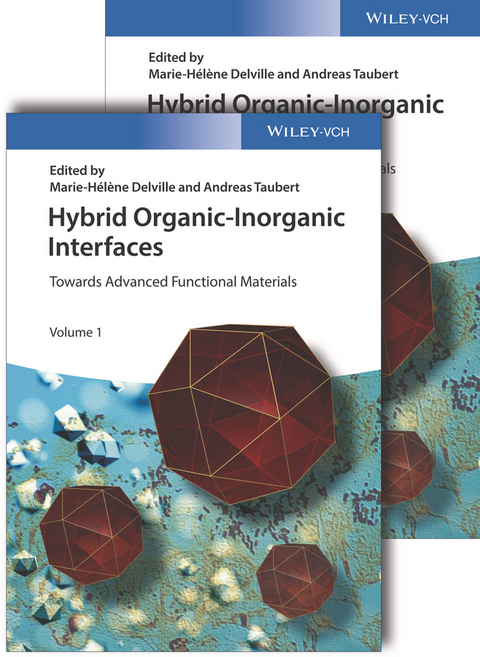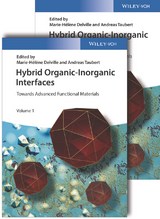Hybrid Organic-Inorganic Interfaces
Wiley-VCH (Verlag)
978-3-527-34255-6 (ISBN)
- Titel ist leider vergriffen;
keine Neuauflage - Artikel merken
Marie-Hélène Delville is a Senior Researcher at French National Centre for Scientific Research CNRS since 1985 and in the Institute of Condensed Matter of Bordeaux since 1997. Her research interests are focused on the fundamental and practical aspects involved in the synthesis of organic-inorganic colloidal nano-objects as well as the role of interfaces. She has been from 2012 to 2016, the chair of a European COST action (Action No MP1202, section Materials, Physics, and Nanosciences) concerning the "Rational design of hybrid organic-inorganic interfaces: the next step towards advanced functional materials". Andreas Taubert is Professor of Supramolecular Chemistry at the University of Potsdam, Germany. After his PhD at the Max-Planck-Institute for Polymer Research in Mainz he was a postdoc at the University of Pennsylvania, USA, and then a group leader at the University of Basel, Switzerland. His research interests are bioinspired hybrid materials and materials chemistry with ionic liquids. Since 2010 he has been one of the organizers of a series of symposia on hybrid materials at the E-MRS Spring Meetings.
PART I. INTERFACE IN 2D/3D NANOCOMPOSITES AND APPLICATIONS
Clay-Organic Interfaces for Design of Functional Hybrid Materials
Hybrid Nanocomposites Based on Prussian Blue Type Nanoparticles Included into Polysaccharides Matrixes
Self-Healing Thermosetting Composites: Concepts, Chemistry and Future Advances
Silica Polymer Interface and Mechanical Reinforcement in Rubber Nanocomposites
Sustainable Organic-Inorganic Interfaces in Energy Applications and Devices
Tough and Stretchable Hydrogels and Their Utilization in Integrated Electronics
Grafting of Conjugated Polymers on Inorganic Substrates: Elaboration of Novel Hybrid Interface for Organic Electronic
Hybrid Organic-Inorganic Nanostructures for Spin Switching and Spintronic
Application of Sol-Gel Method to Synthesize Organic-Inorganic Hybrid Coatings to Minimize Corrosion in Metallic
Gas-Organic and Gas-Inorganic Interfacial Effects in Gas-Adsorbent Interactions: the Case of CO2/ CH4 Separation
Design and Characterization of MOFs (Metal Organic Frameworks) for Innovative Applications
Ionic Liquid Based Approaches to Carbon Materials Synthesis
PART II. THE INTERFACE OF HYBRID MATERIALS IN BIOAPPLICATIONS
Ionic Liquid-Assisted Synthesis of Biomaterials
Interface Engineering with Self-Assembled Monolayers in Biosensors
Coordination Polymers for Medical Applications: Amorphous Versus Crystalline Materials
Chemical Adjustment of the Interface Between Silicate Nanoparticles and Biological Media for Imaging and Therapy
High Pressure Hydrothermal Procedure: A Tool for Surface Modification of Super-Paramagnetic Nanostructured Materials for Medical Applications
Silica-Based Organic-Inorganic Hybrid Nanomaterials for Bioimaging
Lanthanide-Based Nanosystems for Multimodal Imaging
Bio-Hybrids
PART III. INTERFACES MODELING AND IN- AND EX- SITU CHARACTERIZATION TECHNIQUES
In-Situ and Ex-Situ Electrochemical Measurements: Spectroelectrochemistry and Atomic Force Microscopy
Nuclear Magnetic Resonance as a Tool for the Investigation of the Interfaces and Textures of Nanostructured Hybrid Materials
Electrostatic Force Microscopy Techniques for Interphase Characterization
Electron Paramagnetic Resonance as a Tool for in-Situ Characterization of Hybrid Interfaces and Nanomaterials
In-Situ Interface Control Techniques for Advanced Hybrid Materials
Influence of Gold-Surface Interactions on the Josephin Domain Dimerization Mechanism: A Computational Study
SANO Methodology for Simulating Self-Assembly Patterns of Organic Molecules over Metal Surfaces
| Erscheinungsdatum | 24.01.2018 |
|---|---|
| Verlagsort | Berlin |
| Sprache | englisch |
| Maße | 170 x 244 mm |
| Gewicht | 2244 g |
| Themenwelt | Naturwissenschaften ► Chemie |
| Technik ► Maschinenbau | |
| Schlagworte | Anorganische Chemie • Chemie • Chemistry • Dünne Schichten, Oberflächen u. Grenzflächen • Grenzfläche • Inorganic Chemistry • Materials Science • Materialwissenschaften • Organic Chemistry • Organische Chemie • Thin Films, Surfaces & Interfaces • Thin Films, Surfaces & Interfaces |
| ISBN-10 | 3-527-34255-9 / 3527342559 |
| ISBN-13 | 978-3-527-34255-6 / 9783527342556 |
| Zustand | Neuware |
| Informationen gemäß Produktsicherheitsverordnung (GPSR) | |
| Haben Sie eine Frage zum Produkt? |
aus dem Bereich




